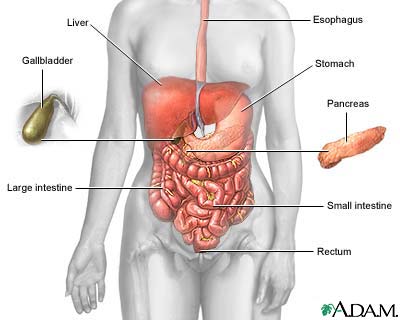Abdominal wall biopsy
Alternative names
Abdominal wall fat pad biopsy; Biopsy - abdominal wall fat pad
Definition
This procedure involves removing a small portion of the abdominal wall “fat pad.” The procedure is done most often to test for amyloidosis.

The esophagus, stomach, large and small intestine, aided by the liver, gallbladder and pancreas convert the nutritive components of food into energy and break down the non-nutritive components into waste to be excreted.
###
How the test is performed
Needle aspiration is the most common method of obtaining an abdominal wall fat pad biopsy. The skin of the abdomen is cleansed, and a local anesthetic may be used to numb the area. A needle is inserted through the skin and into the fat pad under the skin. A small “core” of the fat pad is removed with the needle and sent to the laboratory for analysis.
How to prepare for the test
No special preparation is usually necessary.
Infants and children:
The physical and psychological preparation a parent can provide for this or any test or procedure depends on the child’s age, interests, previous experiences, and level of trust. For specific information regarding how you can prepare your child, see the following topics as they correspond to your child’s age:
- Infant test or procedure preparation (birth to 1 year)
- Toddler test or procedure preparation (1 to 3 years)
- Preschooler test or procedure preparation (3 to 6 years)
- School age test or procedure preparation (6 to 12 years)
- Adolescent test or procedure preparation (12 to 18 years)
How the test will feel
Although your health care provider may have numbed the skin, there can be some mild discomfort or pressure during the needle insertion. Afterward, the area may feel tender or bruised for several days.
Why the test is performed
This test may be performed when amyloidosis is suspected.
Normal Values
The fat pad tissues are normal.
What abnormal results mean
Amyloidosis is the disease most frequently diagnosed by this test.
What the risks are
The risks are minimal. There is a slight risk of infection. There is also a minor risk of bruising or slight bleeding.
Last Edited: Aug 17. 2005
by Levon Ter-Markosyan, D.M.D.
Medical Encyclopedia
All ArmMed Media material is provided for information only and is neither advice nor a substitute for proper medical care. Consult a qualified healthcare professional who understands your particular history for individual concerns.